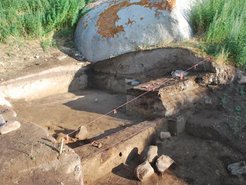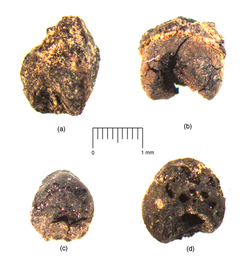First Farmers of Inner Asia
Historians and archaeologists have referred to Inner Asia as the pastoralist realm, arguing that a ‘nomadic’ economy dominated the region in prehistory. However, in recent years, as archaeobotanical methods are becoming more common, it is become clearer that Central Asians in the past maintained a mixed agropastoral system. A distinct package of crops spread through much of the Central Asian foothills by the second millennium B.C.

The popular image of Inner Asia as the realm of the horse-back warrior nomads has permeated the academic literature for nearly a century, in doing so it has directed the nature of research questions asked by academics. Partially due to the generally accepted idea that people in this part of the world were ‘nomads’, archaeobotanical methods have been largely lacking. While archaeologists have studied farming systems in the ancient sedentary agricultural zones in southern Central Asia (Turkmenistan, Tajikistan, and Uzbekistan), which date back to the sixth millennium B.C., the role of farming in the economy of people in eastern Kazakhstan and western China in the past has received little attention. Essentially, why look for farming if it is already accepted that these people were pastoralists? However, starting in 2006, with increased archaeobotanical investigation in eastern Kazakhstan, Dr. Spengler spearheaded the “First Farmers of Inner Asia” program. As a result of this growing research focus, it is becoming increasingly clear that domesticated grains were known in the region at least as far back as the third millennium B.C. and that a mixed agropastoral economy was present by the mid-second millennium B.C. Inner Asia was not only the crossroads of the ancient world, but it was also a center of innovation and cultural development; in this sense, understanding the nature of early economy in the region directly feeds into our understanding of the prehistory of the Old World.

In 2006, Dr. Spengler joined the Dzhungar Mountains Archaeological Project, directed by Michael Frachetti of Washington University in St. Louis, to look at archaeobotancial samples from Begash in eastern Kazakhstan. The Begash site has provided a long sequence of punctuated human occupation and some of the earliest evidence for domesticated grains in the mountains of northern Central Asia. In 2011, Dr. Spengler joined the Tasbas archaeological project, co-directed by Paula Doumani (Nazarbayev University) and Michael Frachetti. The oldest occupation layers at Tasbas have provided the earliest evidence for domesticated grains in the region, dating to the mid-third millennium B.C., and the second millennium B.C. cultural layers at the site have provided clear evidence for a mixed agropastoral economy. Subsequently, the “First Farmers of Inner Asia” program has branched into new areas, maintaining projects in Tajikistan and western China.
Related Publications
Spengler, R. N., III. 2019 Fruit of the Sands: Silk Road Origins of the Food We Eat. Oakland, CA: University of California Press: Berkeley.
Cerasetti, B., Arciero, R., Carra, M., Curci, A., Grossi Mazzorin, J. De, Forni, L., Luneau, E., Rouse, L. M., Spengler, R. N., III. 2019 Bronze and Iron Age Urbanization in Turkmenistan: Preliminary Results From the Excavation of Togolok 1 on the Murghab Alluvial Fan. In: Baumer, C., Novak, M. (Eds.). Urban Cultures of Central Asia From the Bronze Age to the Karakhanids: Learnings and Conclusions From New Archaeological Investigations and Discoveries. Proceedings of the First International Congress on Central Asian Archaeology held at the University of Bern, 4-6 February 2016. pp. 63-72 Harressowitz Verdog: Bern.
Spengler, R. N., III. 2019 Origins of the Apple: The Role of Megafaunal Mutualism in the Domestication of Malus and Rosaceous Trees. Frontiers in Plant Science. 10(617):1-18.
Spengler, R. N., III., Maksudov, F., Bullion, E., Merkle, A., Hermes, T., Frachetti, M. 2018 Arboreal Crops On the Medieval Silk Road: Archaeobotanical Studies at Tashbulak. PLOS ONE. 13(9):e0204582.
Spengler, R. N., III, Nigris, I. de, Cerasetti, B., Carra, M., Rouse, L. M. 2018 The Breadth of Dietary Economy in Bronze Age Central Asia: Case Study From Adji Kui 1 in the Murghab Region of Turkmenistan. Journal of Archaeological Science: Reports. 22:372-381.
Spengler, R. N., III., Maksudov, F., Bullion, E., Merkle, A., Hermes, T., Frachetti, M. 2018 Arboreal Crops On the Medieval Silk Road: Archaeobotanical Studies at Tashbulak. PLOS ONE. 13(9):e0204582.
Spengler, R. N., III, Ryabogina, N., Tarasov, P., & Wagner, M. 2016 The Spread of Agriculture into Northern Asia. The Holocene. 26:1527-1540.
Miller, N. F., Spengler, R. N., & Frachetti, M. 2016 Millet Cultivation across Eurasia: Origins, Spread, and the Influence of Seasonal Climate. The Holocene. 26:1566-1575.
Spengler, R. N., III 2015 Agriculture in the Central Asian Bronze Age. Journal of World Prehistory. 28(3):215–253.
Doumani, P. N., Frachetti, M. D., Beardmore, R., Schmaus, T., Spengler, R. N., & Mar’yashev, A. N. 2015 Bronze Age Mountain Agriculture, Funerary Ritual, and Mobile Pastoralism at Tasbas, Southeastern Kazakhstan. Archaeological Research in Asia. 1-2:17–32
Spengler, R. N., III, Cerassetti, B., Tengberg, M., Cattani, M., & Rouse, L. M. 2014 Agriculturalists and Pastoralists: Bronze Age Economy of the Murghab Delta, Southern Central Asia. Journal of Vegetation History and Archaeobotany. 23:805–820.
Spengler, R. N., Frachetti, M. D., Doumani, P. N., Rouse, L. M., Cerasetti, B., Bullion, E., & Mar’yashev, A. N. 2014 Early agriculture and crop transmission among Bronze Age mobile pastoralists of Central Eurasia. Proceedings of the Royal Society B. 281:20133382.
Spengler, R. N., III, Doumani, P., & Frachetti, M. 2014 Agriculture in the Piedmont of Eastern Central Asia: The Late Bronze Age at Tasbas, Kazakhstan. Quaternary International. 348:147–157.
Spengler, R. N., III, & Willcox, G. 2013 Archaeobotanical Results from Sarazm, Tajikistan, an Early Bronze Age Village on the Edge: Agriculture and Exchange. Journal of Environmental Archaeology. 10(3):211–221.
Frachetti, M. D., Spengler, R. N., Fritz, G. J., & Mar’yashev, A. N. 2010 Earliest Direct Evidence for Broomcorn Millet and Wheat in the Central Eurasian Steppe Region. Antiquity 84:993–1010.
More Information

